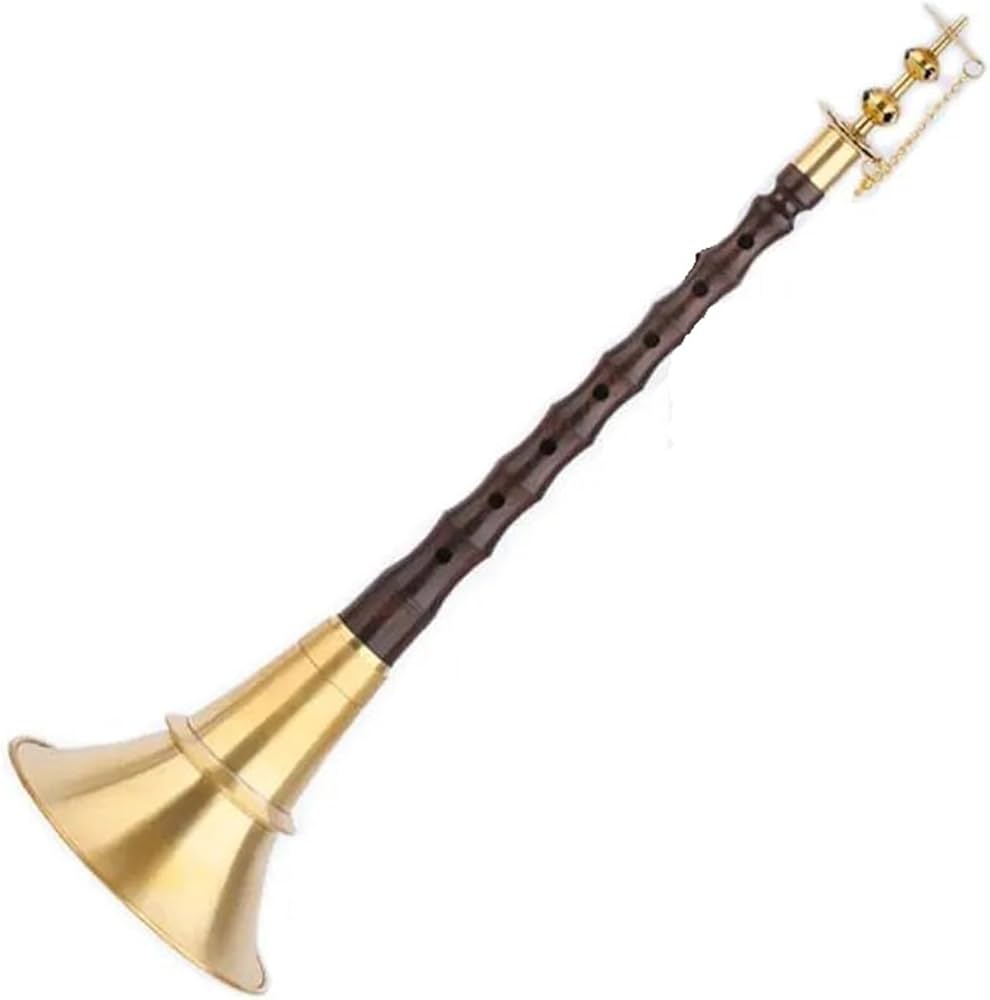Sorna
Woodwinds
Asia
Between 0 and 1000 AD
Video
The sorna, also known as surnay or zurna, is a traditional double-reed wind instrument that has played a significant role in the musical cultures of the Middle East, Central Asia, and parts of Europe. Recognized for its loud and penetrating sound, the sornas are often used in festive and ceremonial contexts, making them an integral part of various cultural celebrations.
Description and Purpose
The sorna is characterized by its conical wooden body, typically made from hardwoods such as apricot or mulberry. The instrument features a double reed attached to a metal staple, which is essential for sound production. It usually has seven finger holes on the front and one thumb hole on the back, allowing musicians to produce a wide range of pitches. The flared bell at the end amplifies the sound, giving the sornas its distinctive bright tone.The primary purpose of the sorna is to provide melodic lines in various musical settings. It is commonly used during weddings, festivals, and religious ceremonies, where its powerful sound can be heard over large crowds. The sornas are often accompanied by percussion instruments like the dohol (a type of drum), enhancing the festive atmosphere during celebrations and processions.
History and Origin
The history of the sorna dates back to ancient times, with origins believed to be in Persia (modern-day Iran). Historical references suggest that similar instruments were used during the Achaemenid Dynasty (550–330 BCE), where they were played at public events and ceremonies. The sorna is mentioned in various Persian literary works, including those by the poet Rumi, indicating its cultural significance.As it evolved over centuries, the sorna adapted to different regional styles and uses.
By the time of the Sasanian Dynasty (224–651 CE), it had become more refined in shape and construction. The instrument spread across regions such as Turkey, Azerbaijan, and parts of Central Asia, where it integrated into local musical traditions. Today, it remains popular in various countries, including Iran, Turkey, and Armenia.
Working Mechanism
The working mechanism of the sorna involves air being blown into a mouthpiece fitted with a double reed. When air passes through the reed, it vibrates against itself to produce sound waves that resonate through the conical body of the instrument. Players can manipulate pitch by covering or uncovering finger holes along the body. The conical bore design enhances sound amplification, allowing for a wide dynamic range from soft tones to powerful blasts.
Types of Sorna
While there are no extensively documented distinct types of sornas based on size or construction, variations may exist based on regional craftsmanship or specific musical contexts. Some common types include Persian Sorna, Turkish Zurna and Armenian Surna. Typically Persian Sorna is used in Iranian folk music and ceremonies. Turkish Zurna is a variant that may have slight differences in construction or tuning. Armenian Surna is adapted for use in Armenian music traditions.
Each type serves specific roles within musical compositions, allowing for a rich tapestry of sound across different cultures.
Features
The sorna is distinguished by several key features:
Distinctive Sound: Known for its loud and bright tone that can project over long distances.
Construction Material: Typically made from hardwoods or bamboo for the body, with a metal bell that enhances projection.
Finger Holes: The seven finger holes allow for agile fingering and pitch variation.
Cultural Significance: The sorna plays an essential role in various cultural traditions and ceremonies, symbolizing heritage and community identity.
The sorna is a vital instrument within many musical traditions with deep historical roots and significant cultural importance. Its unique sound and versatility ensure its continued relevance in both traditional performances and modern musical expressions across different regions.
FAQ
What is the Sorna and its Cultural Significance?
The Sorna is a traditional Iranian double-reed wind instrument that has been part of Persian music for centuries. It is particularly significant in the cultural practices of various ethnic groups in Iran, including the Laks and Bakhtiari. The Sorna is commonly used in festive celebrations, weddings, and mourning ceremonies, symbolizing joy and sorrow within Iranian culture.
How is the Sorna Played?
The Sorna is played by blowing air through a double reed, which produces a loud and penetrating sound. Musicians use their fingers to cover and uncover the instrument's finger holes to create different pitches. The Sorna is often played in pairs, with one musician leading the melody while the other provides a drone, enhancing the overall musical texture.
What Role Does the Sorna Play in Modern Iranian Music?
In modern Iranian music, the Sorna continues to be a vital instrument in folk ensembles and traditional performances. It is frequently featured during cultural festivals and public celebrations, where its vibrant sound adds to the festive atmosphere. The Sorna has also gained recognition beyond Iran, influencing similar instruments in neighboring cultures.
 Links
Links
References
Other Instrument
Categories


















